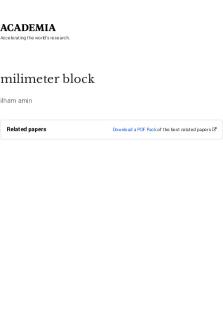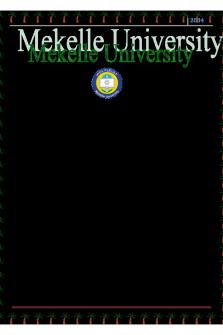HOLLOW BLOCK MAKING MACHINE 2004 ACKNOWLEDGMENT PDF

| Title | HOLLOW BLOCK MAKING MACHINE 2004 ACKNOWLEDGMENT |
|---|---|
| Author | Temesgen Tesfahiwot |
| Pages | 116 |
| File Size | 1.8 MB |
| File Type | |
| Total Downloads | 718 |
| Total Views | 814 |
Summary
HOLLOW BLOCK MAKING MACHINE 2004 Ethiopian Institute of Technology-Mekelle Department of Mechanical Engineering Final year thesis project on DESIGNE O HOLLOW BLOCK MAKING MACHINE In fulfillment of the requirement of Bsc. in Mechanical Engineering By Dahlak Hika (FST/UR 0105/2000) And Zelealem Belay ...
Description
HOLLOW BLOCK MAKING MACHINE 2004
Ethiopian Institute of Technology-Mekelle Department of Mechanical Engineering Final year thesis project on
DESIGNE O HOLLOW BLOCK MAKING MACHINE In fulfillment of the requirement of Bsc. in Mechanical Engineering By Dahlak Hika (FST/UR 0105/2000) And Zelealem Belay (FST/UR 181/1999)
Under the guidance of ABRHA GEBREGEYORGIS (MTECH.)
JUNE 18/2012
DAHLAK HIKA & ZELEALEM BELAY 2004 G.C
ACKNOWLEDGMENT First of all Our deep gratitude goes to the almighty GOD for everything he did to us in all the way we path through, then after for both my adviser Ato abrha and mechanical engineering department staff members for their continues and progressive support, advice and guides us to do better work and give us a reference materials and initiate us for our work and project. In addition, we would like to thank also other local companies, which participate in this block production sector and their employees for their respect, familiarity, their advice and support. In addition, we would like to thank our classmates and friends for sharing their ideas and materials with us. Finally, we would like to thank our families for understanding and helping us with all our needs.
DAHLAK HIKA & ZELEALEM BELAY 2004 G.C
Page 1
ABSTRACT This report presents a systematic approach to enhance the current design of hollow block machine. The design starts with data gathering from the literature review and infoBirration given by the hollow blocks maker. Product specification is then being developed and refine to the specific points. The weaknesses of the current design are being analyzed by looking at the movement waste done by the machine operator and the machine limitation is being identified. The hollow blocks are different from other noBirral blocks as it requires no mortar or cement for masonry work. This blocks interlocked with each other by means of positives and negative frogs on the top and bottom of the blocks which disallow the horizontal movement of blocks. Selection of best design is chosen from the several design concepts proposed. Finally, the drawing and detail design is produced according to standard and ready to be built by the machine developer.
DAHLAK HIKA & ZELEALEM BELAY 2004 G.C
Page 2
TABLE OF CONTENTS ACKNOWLEDGEMENT…………………….………………………….…………………..….. 1 ABSTRACT ……………………………………………………………………………..….….…2 LIST OF TABLES ......................................................................................................................... 7 LIST OF FIGURE……………………………………………………………….......……………9 LIST OF ABBREVIATIONS .................................................................................................. 11 LIST OF SYMBOLS
............................................................................................................ 11
LIST OF APPENDICE ................................................................................................................. 12 PROBLEM STATEMENT…………………………………………………………..…………..14 OBJECTIVE……………………………………………………………………………………. 15 SCOPE…………………………………………………………………………………………...16 CHAPTER ONE INTRODUCTION ....................................................................................... 19 1.0 Introduction. .......................................................................................................................... 19 1.1 Hollow block specification………..…………………………………………………..…20 1.1.1 Producuction of hollow block process……………………………………………...20 1.2 Introduction of block product………...………………………………………………….21 1.2.1 Concrete block.......................................................................................................... 21 1.2.2 Background .............................................................................................................. 22 1.2.3. Market& demand aspect………………………………………………….……..…23 1.2.4 Types of concrete block……………………………………………………….……23 1.2.5 Input material for cement block……………………………………………. ……..25 1.2.6 Manufacturing process of blocks…………………………………………………..26 1.3 Block making process…………………………………………………………..………..28
DAHLAK HIKA & ZELEALEM BELAY 2004 G.C
Page 3
CHAPTER TWO 2. 1 LITERATURE REVIE 2.1.1 Background and justification of the H.B.P.M………………………..….…….…...30 2.1.2 Hollow Concrete blocks……….………………………………………………..…...32 CHAPTER THREE 3 METHODOLOGY 3.1 Introduction………………………………………………………………………..…..34 3.1.1 Concept development phase ……………..................................................................34 3.1.2 Establishing target specifications …………………………………………………..35 3.1.3 Concept generation ………………………………………………………………...35 3.1.4 Concept selection…………………………….…………………………………….35 3.1.5 Setting final specification ………………………………………………………….35 3.1.6 Concept development….……………………………………………………………37 3.1.7 Establishing target specifications …………………………………………………..38 3.1.8 Concept generation …………………………………………………………………43 3.1.9 prblem identification………………………………………………………………...43 3.2.0 Concept selection …………………………………………………………………..50 3.2.1 Discussion ………………………………………………………………………….53 CHAPTER FOUR 4.1 DESIGN ANALYSIS .......................................................................................................... 55 4.1.1 Motor selection…………………………………….……………….…..……………...56 4.1.2 Bearing selection…………………..………………………………………………….58 4.1.3 Design of Welded joints……………………………………………………………...62 4.1.4 Design of spring……………………………………………………………………...64 4.1.5 Design of Bolt……………………………………………………………………….. 70
DAHLAK HIKA & ZELEALEM BELAY 2004 G.C
Page 4
4.1.6 Design of double acting cylinder………………………………………………………71 4.1.7 Design of support frame............................................................ ……………………….75 4.1.8 Design of mould base…………………………………………………………………..76 CHAPTER FIVE 5 RESULT AND DISCUSSION…………………………....... ……........................................78 5.1 Product architecture………………………………………………………………….. 78 5.2 Components analysis ……………………………………………………………….…91 5.2.1 Top Structure…………………………………………………………………….91 5.2.2 Table Structure…………………………………………………………………....93 5.2.3 Compactor Structure ………………………………………………………..…..95 5.2.2 Planar base Structure ………….…………………………………………………97 5.3 Cost analysis ……………………………………………………………………………99 5.3.1 Guideline for Calculating Bricks selling Price ………………………………….99 5.3.2 Machine component and Raw Material Cost…………………………………...102 5.3.3 Material cost estimtion…………………………………………………………..104 5.3.4 Mnufacturing cost………………………………………………………………..106 5.3.5 Product design specification …………………………………………….……...108 CHAPTER SIX 6. CONCLUSION 6.1 Introduction ……………………………………………………………….………….110 6.2 Conclusion……………..…………………………………………………………… .110 6.3 Future Development …………………………………………………………………111 DAHLAK HIKA & ZELEALEM BELAY 2004 G.C
Page 5
RECMMENDATION………………………………………………………………………….112 REFERENCES…………………………………………………………………………………113 APPENDICES …………………………………………………………………………………116
DAHLAK HIKA & ZELEALEM BELAY 2004 G.C
Page 6
LIST OF TABLES TITLE
PAGE
Table 1.1 Customer statement and interpretation……………………………………24 Table 3.1 interview of hallow block producers………………………………………37 Table 3.2 customer needs……………………………………………………………..42 Table 3.3 Matrix table .……………………………………………………………….42 Table 3.4 Needs-matrix table …………………………………………………………43 Table 3.5 Concept 1 description………………………………………………………44 Table 3.6 Concept 2 description………………………………………………………47 Table 3.7 Concept 3 description
……………………………………………………49
Table 3.8 Concept screening matrix ………………………………………………….51 Table 4.1.1 life of bearing for various type of machine………………………………60 Table 4.1.2 values of service factor …………………………………………………..61 Table 4.1.3 stress for welded joint……………………………………………………64 Table 4.1.4 stress concentration factor ………………………………………………64 Table 4.1.5 types of ends of spring ………………………………………………….66 Table 4.1.6 stress in helical spring ………………………………………………….66 Table 4.1.7 Material cost ……………………………………………………………104 Table 4.1.8 Screw and nuts cost ……………………………………………………105 Table 4.1.9Mechanical system and equipment cost………………………………...107
DAHLAK HIKA & ZELEALEM BELAY 2004 G.C
Page 7
Table 4.2. Manufacturing cost
…………………………………………………107
Table 4.2.1 Final product design specification…………………………………….109
DAHLAK HIKA & ZELEALEM BELAY 2004 G.C
Page 8
LIST OF FIGURES TITLE
page
Figure A Flow chart represents the scope of work…………………………….…..18 Figure 1.1 manufacturing process of block………………………………….……..20 Figure 1.2 Type of Hollow Block…………………………………………………..22 Figure 2.1 machine used for the production of H.B………….……………………32 Figure 2.2 filling in to the concrete block…………………………………………..33 Figure 2.3 cleaning the top and removing mould…………………………………..33 Figure 2.4 method of designing hollow block ……………………..………………36 Figure 3.1 Method of designing the hollow block making machine……………….36 Figure 3.2 Concept 1-Cantilever concept…………………………………… …….44 Figure 3.3 Concept 2-Cantilever concept…………………………………………..46 Figure 3.4 Concept 3-Center cylinder concept……………………………………..48 Figure 4.1.1types of bearing…………………………………………..……………59 Figure 4.1.2 ball bearing…………………………………………………………….61 Figure 4.1.3 welded lap joint ……………………………………………………….63 Figure 4.1.4 spring expression ……………………….…………………………….65 Figure 4.1.5 bolted joint……………………………………………………………..70 Figure 4.1.6 Hydraulic circuit diagram……….……………………………………..71 Figure 4.1.7 valve representation ……………………………..……………………74 Figure 4.1.8 mould base assembly …………………………………………………76 DAHLAK HIKA & ZELEALEM BELAY 2004 G.C
Page 9
Figure 4.1.9 mould assembly design…………………………………………….….79 Figure 4.2 Top structure displacement result ………………………………………80 Figure 4.2.1 churcging system ………………………………………………………81 Figure 4.2.2 inside control panel ……………………………………………………82 Figure 4.2.3 top structure stress analysis……………………………………………91 Figure 4.2.3 top structure displacement result…………………………..………….92 Figure 4.2.3 table structure stress analysis…………………………………………93 Figure 4.2.3 Compactor structure displacement result……………………………...95 Figure 4.2.3 Compactor structure stress analysis……………………………….......96 Figure 4.2.4 Compactor structure displacement result………………………………96 Figure 4.2.5 Planar Base structure stress analysis…………………………………...98 Figure 4.2.6 Planar base structure displacement result………………………..…….98 Figure Cement charging/loading
.
Figure Table assembly drawing Figure Top structure assembly drawing Figure Charging system assembly drawing Figure Table structure assembly design Figure Top structure assembly design Figure Charging system assembly design Figure Top structure stress analysis Figure Table structure stress analysis
DAHLAK HIKA & ZELEALEM BELAY 2004 G.C
Page 10
LIST OF ABBREVIATIONS
CAE
- Computer Aided Engineering
CATIA
- Computer Aided Three-Dimensional Interactive Application
D
- Bore Diameter
DfX
- Design for Assembly, Manufacturing, and Environment
EDM
- Electrical Discharge Machine
Kg
- Kilogram
KN
- Kilo Newton
PDS
- Product Design Specification
LIST OF SYMBOLS π
- pi (3.1415)
P
- Pressure
ᵒC
- Degree Celsius
ᵒF
- Degree Fahrenheit
DAHLAK HIKA & ZELEALEM BELAY 2004 G.C
Page 11
LIST OF APPENDICES TITLE
page
A-1
Machine assembly drawing
116
A-2
Mold assembly drawing
117
A-3
Table assembly drawing
118
A-4
Top structure assembly drawing
119
A-5
Charging system assembly drawing
120
A-6
Block pusher drawing
121
A-7
Charger drawing
122
A-8
Compactor drawing
123
A-9
Container drawing
124
A-10
Cover drawing
125
A-11
Hinge drawing
126
A-12
Middle bar drawing
127
A-13
Mold drawing
128
A-14
Movable base drawing
129
A-15
Planar base drawing
126
A-16
Horizontal plate structure drawing
130
A-17
Pusher base drawing
131
A-18
Pusher shaft drawing
132
A-19
Rod drawing
133
DAHLAK HIKA & ZELEALEM BELAY 2004 G.C
Page 12
A-20
Slider base drawing
134
A-21
Slider compactor drawing
135
A-22
Slider pusher drawing
136
A-23
Structure table 1 drawing
137
A-25
Structure base drawing
138
A-24
Structure table 2 drawing
139
A-26
Table structure drawing
140
A-27
Top mold drawing
141
A-28
Top structure 1 drawing
142
A-29
Top structure 2 drawing
143
B-1
Hydraulic cylinder
144
B-4
Vibration motor
145
C-1
Socket hex cap screw
146
C-2
Bolt, washer and nut
147
C-3
Bearing bush
148
DAHLAK HIKA & ZELEALEM BELAY 2004 G.C
Page 13
PROBLEM STATEMENT Today in our country the problems of homeless have been increasing gradually and it appear to be continue the main reason for the cause will be higher cost of construction raw materials, poverty, low income and lack of new technology Since the government of Ethiopia focus to build thousands of low cost house throughout the country, to meet the millennium development goals and achieve significant reduction in poverty the introduction of compacted block making machine must be essential. Nowadays providing house to our community at an affordable price is a major task being carried out by our government and real state organizations. Hollow blocks and burnt blocks are a colossal input for the construction of those low cost houses, but the currently in use hollow block and burned block construction materials in our country are expensive and take long time to manufacture and construct, which makes the selling price of those hoses expensive and take long time to manufacture and construct, which makes the selling price of those hoses expensive and take long time to manufacture and construct, which makes the selling price of those hoses expensive and unaffordable for the medium income society. In addition to this those construction materials has the following drawbacks:
high moisture penetration
low theBirral efficiency
difficulties for electric & plumbing jobs insects
cost inefficiency bad finishes
it is difficult to produce on site
water absorption
higher cost & time consuming
higher unit weight low control over quality
DAHLAK HIKA & ZELEALEM BELAY 2004 G.C
Page 14
OBJECTIVE OF THE PROJECT General objective The main objective of this project is to design a new blocks making machine with new features and simplifying the machine for one man operation in order to reduce operational cost and maximize the production rate. FurtheBirrore, the purpose of this is to design the hollowblocks making machine that suitable for SME entrepreneurs.
Specific objective To bring building construction of low cost houses effective, easier and faster using the CBMM To achieve superior finishes and compatible for almost all types of construction. To have on site production to reduce transportation cost and to minimize ecological imbalance caused due to burnt blocks. General it aims high strength and technical superiority over conventional methods. To achieve lighter than conventional masonry and hollow blocks save no mortar & plaster cost.
Problem Identification Current machine design unable to increase productivity, this is mainly due to;
i.
Time wasting by doing the cement charging, loading and leveling, (Time required 50 seconds).
ii.
Manually obtaining the lower mold plate as operator needs the device to turn the block (Time required 45 seconds).
iii.
The load applied several time on the hollow block (Time required: 15 seconds)
iv.
Operator need to manually pick-up the block one by one after compaction process before start the new process cycle (Time required: 20 seconds).
v.
The mold lower plates are manually inserted one by one (Time required 45 seconds).
DAHLAK HIKA & ZELEALEM BELAY 2004 G.C
Page 15
Expected results and Scope From the above interview, we conclude that customer’s needs are High production rate, Minimum 3 blocks per cycle, One-man operation, Simple operation,
Comes with auto arrange block system, Comes with cement charging system, Comes with cooling system, Fool proof operation, Automated function,
UnifoBirr pressure distribution, Can be easily maintainable. Safe to handle,
Low cost machine,
Marketable machine,
Comes with alert system And also The high aesthetic value, faster, theBirrally efficient, structurally durable, eco-friendly, and low cost block will be identified for the production of low cost house in the country. The analysis of this project is limited to the manufacturing of compacted block making machine for producing blocks with dimensions (21*10*15cm) by applying 4.5 Mpa of compressing pressure between the compressing mould of the machine at low cost. N:B the compressive strength of both hollow blocks and hollow clay burned blocks range from 2Mpa up to 7Mpa it is acceptable in the Ethiopian standards for load bearing walls .(ESC.D4.026),(ESC D3 301). With system pressure of compacting 9-10 Mpa, cement content of 5-8% clay silt content of 10&50% a typical block can be made with a compression strength ranging from 4-7 Mpa this compression strength for load bearing walls in the Ethiopian standard will be acceptable.
DAHLAK HIKA & ZELEALEM BELAY 2004 G.C
Page 16
With over all dimension of the machine (120*150*147cm) and
Motor driven two hydraulic units with 7.5 Mpa.
Capacity 1500 blocks/12 hours
Power 4 kw
Net weight 300 kg
The main task to be done on the design of hollow block making machine Is to design machine that can produce 1. Three block wit L=400mm, W=200mm, t=20mm 2. Four block with L=400mm, W=150mm, t=20mm 3. Five block with L=400mm, W=100mm, t=20mm
1.2 Scope of project The scope of project is clearly define the specific field of the research and ensure that the entire content of this thesis is confined the scope. This project is start with the literature review on product specification in order to satisfy the project objectives. After obtaining...
Similar Free PDFs

Legend Of Sleepy Hollow
- 27 Pages

Block 4
- 9 Pages

Block 3
- 7 Pages

Dept 2004
- 4 Pages

milimeter block
- 2 Pages

Yager 2004
- 15 Pages

Moore Machine and mealy machine
- 1 Pages

Ensayo Sleepy Hollow - Grade: 9
- 5 Pages

Atrioventricular Block
- 19 Pages

Block 5
- 15 Pages
Popular Institutions
- Tinajero National High School - Annex
- Politeknik Caltex Riau
- Yokohama City University
- SGT University
- University of Al-Qadisiyah
- Divine Word College of Vigan
- Techniek College Rotterdam
- Universidade de Santiago
- Universiti Teknologi MARA Cawangan Johor Kampus Pasir Gudang
- Poltekkes Kemenkes Yogyakarta
- Baguio City National High School
- Colegio san marcos
- preparatoria uno
- Centro de Bachillerato Tecnológico Industrial y de Servicios No. 107
- Dalian Maritime University
- Quang Trung Secondary School
- Colegio Tecnológico en Informática
- Corporación Regional de Educación Superior
- Grupo CEDVA
- Dar Al Uloom University
- Centro de Estudios Preuniversitarios de la Universidad Nacional de Ingeniería
- 上智大学
- Aakash International School, Nuna Majara
- San Felipe Neri Catholic School
- Kang Chiao International School - New Taipei City
- Misamis Occidental National High School
- Institución Educativa Escuela Normal Juan Ladrilleros
- Kolehiyo ng Pantukan
- Batanes State College
- Instituto Continental
- Sekolah Menengah Kejuruan Kesehatan Kaltara (Tarakan)
- Colegio de La Inmaculada Concepcion - Cebu





